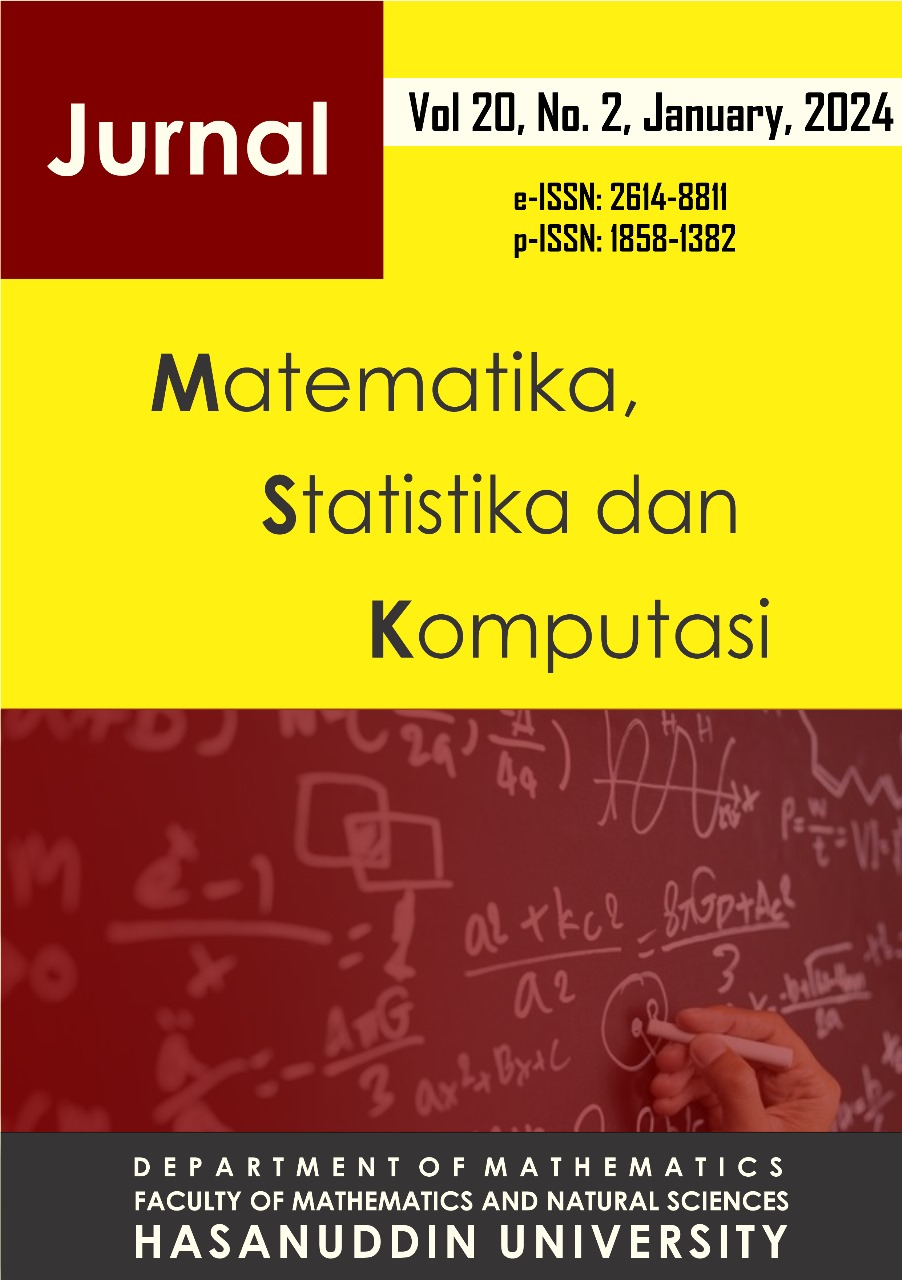Comparative Analysis of Ridge, LASSO, and Elastic Net Regularization Approaches in Handling Multicollinearity for Infant Mortality Data in South Sulawesi
DOI:
https://doi.org/10.20956/j.v20i2.31632Keywords:
elastic net, infant mortality, multicollinearity, regularizationAbstract
Infant mortality rate is a crucial indicator for assessing the health and infant care quality in a region. In the effort to reduce infant mortality rates, regression analysis serves as a tool to identify influential factors. However, regression analysis often encounters the challenge of multicollinearity, which involves high correlation among predictor variables. To address this issue, various regularization techniques can be applied, such as ridge regression, least absolute shrinkage and selection operator (LASSO), and elastic net. Ridge regression aims to control coefficient variance, while LASSO directs some coefficients to zero, functioning as variable selection. Elastic net combines the strengths of both methods by merging ridge and LASSO regularization. The objective of this research is to evaluate the performance of ridge regression, elastic net, and LASSO methods in handling multicollinearity issues, utilizing infant mortality rate data in South Sulawesi Province. The results indicate that the elastic net method outperforms both Ridge and LASSO methods. The best-performing model is obtained through elastic net with a coefficient of determination value of 60.81%, whereas ridge and LASSO methods yield coefficient of determination values of 54.11% and 58.18%, respectively. This demonstrates that the application of the elastic net method is capable of producing more accurate results in modeling the variables within the analysis of infant mortality rate data compared to other methods.
References
Altelbany, S., 2021. Evaluation of Ridge, Elastic Net and Lasso Regression Methods in Precedence of Multicollinearity Problem: A Simulation Study. Journal of Applied Economics and Business Studies, Vol. 5, No. 1, 131–142.
Araveeporn, A., 2021. The higher-order of adaptive lasso and elastic net methods for classification on high dimensional data. Mathematics, Vol.9 No. 10, 1–14.
Fanny, R., Djuraidah, A., & Alamudi, A., 2018. Pendugaan Produktivitas Bagan Perahu dengan Regresi Gulud, LASSO dan Elastic-net. Xplore: Journal of Statistics, Vol. 2, No 2, 7–14.
Gujarati, D. N., 2021. Basic econometrics. In Prentice Hall.
Gupta, V. (2019). Evaluating the Accuracy of Valuation Multiples on Indian Firms Using Regularization Techniques of Penalized Regression. Theoretical Economics Letters, Vol. 9, No. 01, 180–209.
Handayani, A., & Wachidah, L., 2022. Metode Regresi Elastic-Net untuk Mengatasi Masalah Multikolinearitas pada Kasus Tingkat Pengangguran Terbuka di Provinsi Jawa Barat. Bandung Conference Series: Statistics, Vol. 2, No. 2, 459–465.
Ikhsan, E., & Ratu, N. Y., 2021. Small Area Estimation untuk Estimasi Angka Kematian Bayi di Indonesia menggunakan Metode Empirical Best Linear Unbiased Prediction. Jurnal Biometrika Dan Kependudukan, Vol. 10, No 2, 171–180.
Kusuma, G. W., & Wulansari, I. Y., 2019. Analisis Kemiskinan Dan Kerentanan Kemiskinan Dengan Regresi Ridge, Lasso, Dan Elastic-Net Di Provinsi Jawa Tengah Tahun 2017. Seminar Nasional Official Statistics, Vol. 1, No. 1, 503–513.
Mayapada, R., Tinungki, G. M., & Sunusi, N., 2018. Penerapan Sparse Principal Component Analysis dalam Menghasilkan Matriks Loading yang Sparse. Jurnal Matematika Statistika Dan Komputasi, Vol. 15, No. 2, 44.
Ningsih, S., & Dukalang, H. H., 2019. Penerapan Metode Suksesif Interval pada Analsis Regresi Linier Berganda. Jambura Journal of Mathematics, Vol. 1, No. 1, 43–53.
Palupi, W. R., & Rizki, L. K., 2020. Analysis of Factor Affecting Infant Mortality Rate (Imr) in East Java Using Multiple Linear Regression. Jurnal Biometrika Dan Kependudukan, Vol. 9, No. 1, 69–76.
Sartika, I., Naomi Nessyana, D., & Nurfitri, I., 2020. Analisis Regresi Dengan Metode Least Absolute Shrinkage and Selection Operator (Lasso) Dalam Mengatasi Multikolinearitas. Bimaster : Buletin Ilmiah Matematika, Statistika Dan Terapannya, Vol. 9, No. 1, 31–38.
Sonawane, M. A., & Tayade, A. Y., 2021. Predictive Model on Determinants of Child Mortality Using Multiple Regression Analysis. Journal of Physics: Conference Series, Vol. 1, No. 1, 1–6.
Srivastava, S., Upadhyay, S. K., Chauhan, S., & Alagarajan, M., 2021. Preceding child survival status and its effect on infant and child mortality in India: An evidence from National Family Health Survey 2015–16. BMC Public Health, Vol. 21, No. 1, 1–12.
Wicaksono, F., Susanto, B., & Farida, F., 2022. The Effect of Environmental Performance, Environmental Costs, and Environmental Disclosure on Profitability of Manufacturing Companies Listed in Indonesia Stock Exchange 2016 - 2020. Urecol Journal. Part B: Economics and Business, Vol. 2, No. 1, 32–42.
Wunderlich, K., & Thompson, E., 2018. Estimating Health Care Costs among Fragile and Conflict Affected States: An Elastic Net-Risk Measures Approach. International Journal of Public Health Science (IJPHS), Vol. 7, No. 3, 175–185.
Zou, H., & Hastie, T., 2005. Regularization and variable selection via the elastic net. Journal of the Royal Statistical Society. Series B: Statistical Methodology, Vol. 67, No. 2, 301–320.
Downloads
Published
How to Cite
Issue
Section
License
Copyright (c) 2023 Author and publisher

This work is licensed under a Creative Commons Attribution 4.0 International License.

This work is licensed under a Creative Commons Attribution 4.0 International License.
Jurnal Matematika, Statistika dan Komputasi is an Open Access journal, all articles are distributed under the terms of the Creative Commons Attribution License, allowing third parties to copy and redistribute the material in any medium or format, transform, and build upon the material, provided the original work is properly cited and states its license. This license allows authors and readers to use all articles, data sets, graphics and appendices in data mining applications, search engines, web sites, blogs and other platforms by providing appropriate reference.







